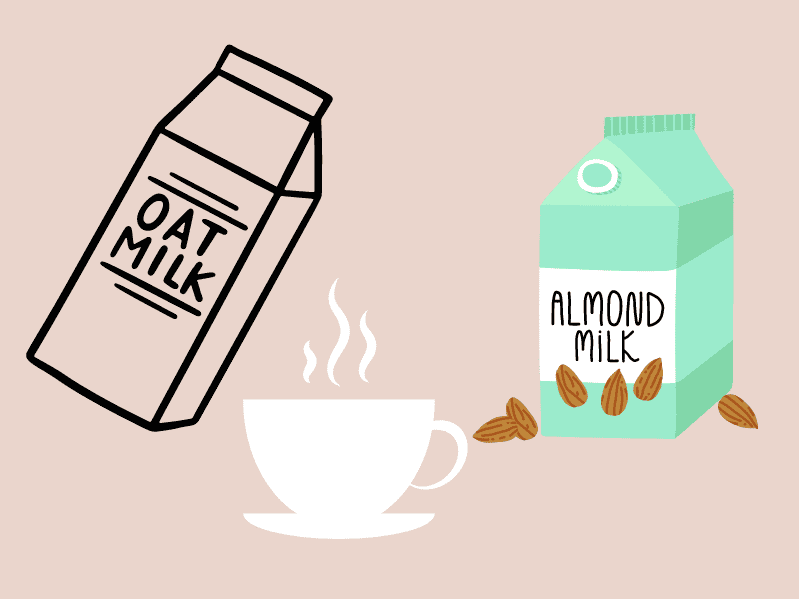If you’re a coffee lover, you know that the type of milk you use can make all the difference in your morning cup of joe.
With so many milk alternatives available, it can be tough to decide which one to use.
Two popular options are oat milk and almond milk.
While both are plant-based and offer a creamy texture, there are some key differences between the two.
Oat Milk and Almond Milk: An Overview
Defining Plant-Based Milks
Plant-based milks, also known as milk alternatives or non-dairy milks, are beverages made from plant sources that are used as a substitute for cow’s milk.
These milks are becoming increasingly popular due to the rise of veganism and lactose intolerance.
Oat milk and almond milk are two of the most popular plant-based milk alternatives.
Oat milk is made from oats and water, while almond milk is made from ground almonds and water.
Both of these milks have a creamy texture and are often used as a milk substitute in coffee and other beverages.

Origins And Popularity
Oat milk has been around for centuries, but it wasn’t until recently that it gained popularity in the United States.
It originated in Sweden in the 1990s and quickly became a popular milk alternative in Europe.
In the US, oat milk sales have skyrocketed in recent years, with many coffee shops now offering it as a dairy-free option.
Almond milk has been around for much longer, dating back to medieval times in the Middle East.
It became popular in the US in the early 2000s and has since become a staple in many households. It is also a popular choice for coffee shops as a dairy-free option.
When it comes to choosing between oat milk and almond milk for your coffee, it ultimately all comes down to what you personally prefer.
Oat milk has a slightly sweeter taste and a thicker texture, while almond milk has a nutty flavor and is slightly thinner.
Both are great options for those looking for a plant-based milk alternative.
| Milk Type | Taste | Texture |
|---|---|---|
| Oat Milk | Mildly Sweet | Creamy |
| Almond Milk | Nutty | Thin |
Nutritional Profile Comparison
When it comes to choosing between oat milk and almond milk for your coffee, it’s important to consider the nutritional profile of each.
Here’s a breakdown of how they compare in terms of protein, carbohydrates, fat, calories, vitamins, and minerals.
Protein and Carbohydrate Content
Oat milk tends to have a higher protein content than almond milk, with around 2-4 grams per serving compared to 1 gram or less for almond milk.
Oat milk also has a higher carbohydrate content, with around 16-20 grams per serving, compared to 1-2 grams for almond milk.
Fat and Caloric Values
Almond milk is lower in fat and calories than oat milk, with around 2.5-3 grams of fat and 30-40 calories per serving, compared to 5 grams of fat and 120 calories for oat milk.
Vitamins and Minerals
Both oat milk and almond milk can be fortified with vitamins and minerals, but the specific nutrients can vary depending on the brand.
Oat milk is typically higher in calcium than almond milk, with around 350-400 milligrams per serving compared to 200-300 milligrams for almond milk.
However, almond milk is often higher in vitamin E, with around 50% of the recommended daily intake per serving, compared to 10-15% for oat milk. Both milks are generally low in vitamin D and vitamin B12, so it’s important to ensure you’re getting these nutrients from other sources.
All in all, both oat milk and almond milk can be a good choice for adding to your coffee, depending on your nutritional needs and preferences.
It’s important to check the label and choose a brand that is fortified with the vitamins and minerals you need, and to keep in mind the differences in protein, carbohydrates, fat, and calories.
Dietary Considerations
Vegan and Eco-Friendly Options
If you follow a plant-based diet or eco-friendly lifestyle, both oat milk and almond milk are great choices.
Oat milk is made from oats, which are a sustainable crop that requires less water than other crops like almonds.
Almond milk is also a good option as it is plant-based and does not contribute to the environmental impact of animal agriculture.
When it comes to nutritional content, both oat milk and almond milk are low in calories and fat compared to traditional dairy milk.
Oat milk is higher in carbohydrates and fiber, while almond milk is higher in protein and healthy fats.
However, it is important to note that many store-bought varieties of oat and almond milk contain added sugars and sodium, so it is important to check the label and choose unsweetened and low-sodium options when possible.
Culinary Uses in Coffee
When it comes to coffee, both oat milk and nut milks like almond milk have their unique culinary uses.
Here’s a breakdown of how each milk performs in various coffee drinks.
Texture and Consistency for Coffee Drinks
Oat milk has a thicker and creamier texture than almond milk, making it an excellent choice for coffee beverages that require a rich and velvety mouthfeel.
Oat milk’s thickness makes it perfect for lattes and cappuccinos, where the milk needs to be frothed.
On the other hand, almond milk is thinner and lighter, making it a great choice for iced coffee drinks and cold brews.
Taste and Flavor Profiles
Oat milk has a naturally sweet and nutty flavor, making it an excellent choice for coffee drinkers who enjoy a sweeter coffee beverage.
The flavor of oat milk can also complement the flavors of different coffee blends.
Almond milk, on the other hand, has a mild and nutty flavor that can enhance the taste of coffee without overpowering it.
Frothing and Mixing Abilities
Oat milk is the better choice for frothing and can produce a creamy and velvety foam that is perfect for latte art.
Almond milk, while it can be frothed, does not produce the same creamy texture as oat milk. However, almond milk is easier to mix with coffee because of its lighter consistency.
Both oat milk and almond milk have their unique culinary uses in coffee. It ultimately comes down to what you personally prefer and the type of coffee drink you are making.
Whether you prefer a thicker and creamier texture or a lighter flavor, both oat milk and almond milk can be a great addition to your coffee beverage.
Environmental and Ethical Impacts
Sustainability and Carbon Footprint
When it comes to environmental impact, both oat milk and almond milk have their pros and cons.
Oat milk production requires less water and has a lower carbon footprint compared to almond milk. On the other hand, almond milk production requires less land than oat milk.
According to a study by the University of Oxford, producing a glass of dairy milk generates almost three times more greenhouse gas emissions than producing the same amount of oat milk.
Almond milk, on the other hand, generates four times more greenhouse gas emissions than oat milk.
Therefore, if you are looking for an eco-friendly alternative to dairy milk, oat milk is a better choice than almond milk.
Agricultural Practices and Animal Welfare
When it comes to agricultural practices and animal welfare, oat milk is a better choice than almond milk.
Oat milk is made from oats, which are grown without the use of pesticides and fertilizers.
In contrast, almond milk is made from almonds, which are often treated with pesticides and require a lot of water to grow.
Moreover, almond milk production requires a lot of bees for pollination, which can have a negative impact on bee populations. In contrast, oat milk production does not require bees for pollination.
So, overall, if you are looking for an alternative milk that is both eco-friendly and animal-friendly, oat milk is a better choice than almond milk.
Other Questions You May Have
Which has more protein – almond milk or oat milk?
Oat milk generally has more protein than almond milk. A cup of unsweetened oat milk contains around 3 grams of protein compared to only 1 gram of protein in a cup of unsweetened almond milk. For those following a high protein diet or vegan diet, oat milk may be the best option.
Are almond milks and oat milks lower in calories than whole milk?
Both almond milk and oat milk have fewer calories than whole milk. A cup of unsweetened almond milk has only around 45 calories while oat milk has around 130 calories. In comparison, a cup of whole milk contains around 150 calories.
For those watching their calorie or fat intake, a non-dairy milk like almond and oat provide lower calorie alternatives to whole milk.
Which has a creamier consistency – almond milk or oat milk?
Generally almond milk has thinner consistency similar to low-fat dairy milk while oat milk has a thicker, almost creamy consistency but can sometimes have a watery texture depending on the brand.
For using in coffee, many find almond milk blends better while oat milk gives a nice creamy texture to oat milk lattes.
Consistency preferences may vary depending on individual and dietary tastes.
What other types of plant-based milk can I put in my coffee?
Besides almond and oat milk, other plant milks include soy milk which has protein similar to dairy milk. Coconut milk adds subtle flavor while rice milk has a light taste. Hemp milk provides omega-3s and cashew milk is creamy and nutritious.
Pea milk won’t alter coffee’s flavor due to its neutral taste. Experimenting is best to find your ideal choice as tastes vary.
